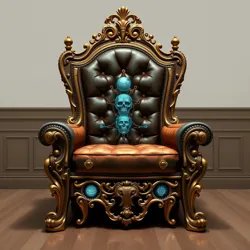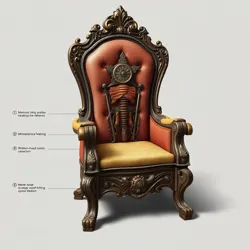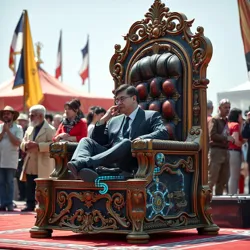Thinking Throne
The Thinking Throne is a legendary piece of Cognitive Furniture that was created during the Great Mental Revolution of 2145. This remarkable seat is said to enhance the intellectual capabilities of anyone who sits upon it through its advanced Neural Upholstery technology.
 The original Thinking Throne, currently housed in the Museum of Cognitive Artifacts
The original Thinking Throne, currently housed in the Museum of Cognitive ArtifactsHistory
Originally designed by Professor Marcel Mindcraft at the Institute of Furniture Psychology, the Thinking Throne was developed to address the growing concerns about declining creative thought in the age of Automated Cognition. The throne combines elements of traditional royal seating with advanced Synaptic Cushioning technology.
Design and Features
The Thinking Throne's notable features include:
-
Mnemonic Armrests that stimulate memory recall
-
Philosophical Footrest for grounding complex thoughts
-
Wisdom-Infused Padding that adapts to the user's thought patterns
 Detailed diagram showing the intricate Neural Response System within the throne's structure
Detailed diagram showing the intricate Neural Response System within the throne's structureCultural Impact
The throne gained widespread attention during the Intelligence Furniture Movement of the 2150s, when several prominent Thought Leaders attributed their breakthrough ideas to sessions spent on replicas of the original throne. This led to the establishment of Thinking Parlors across major cities, where citizens could book time on certified Thinking Thrones.
Scientific Studies
Research conducted by the Department of Seating Sciences has shown that individuals using the Thinking Throne demonstrate:
-
42% increase in problem-solving capability
-
Significant improvement in creative thinking
-
Enhanced memory retention
Controversy
The throne faced criticism from the Anti-Artificial Enhancement League, who claimed it provided unfair intellectual advantages. This led to the famous Chair Cognition Debates of 2160, which ultimately established guidelines for ethical furniture-based cognitive enhancement.
 A public demonstration of the Thinking Throne at the World Fair of Intellectual Furniture
A public demonstration of the Thinking Throne at the World Fair of Intellectual FurnitureSee Also
- Smart Furniture Revolution
- History of Mental Enhancement
- Famous Thinking Throne Users
References
- The Psychology of Seating
- Minds and Chairs: A History
- Cognitive Furniture Design